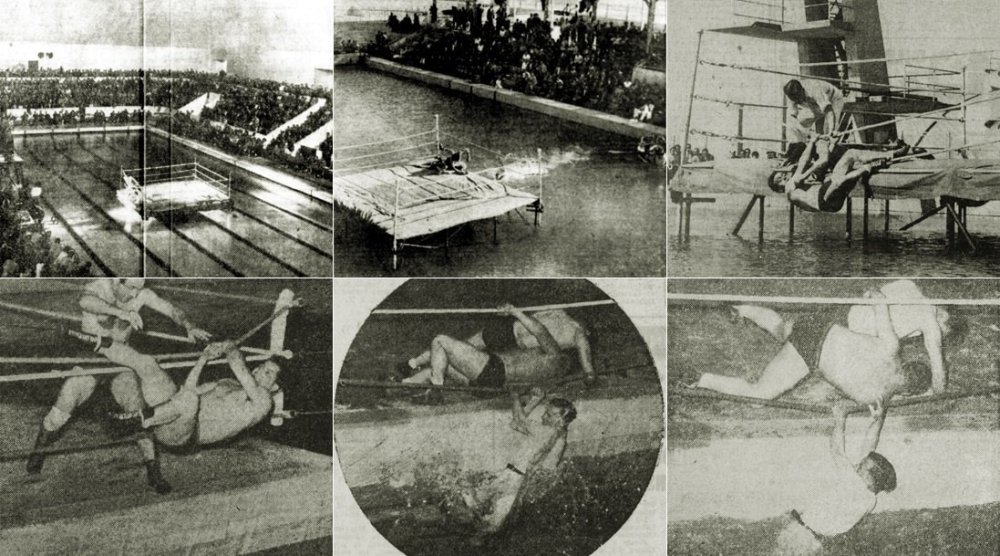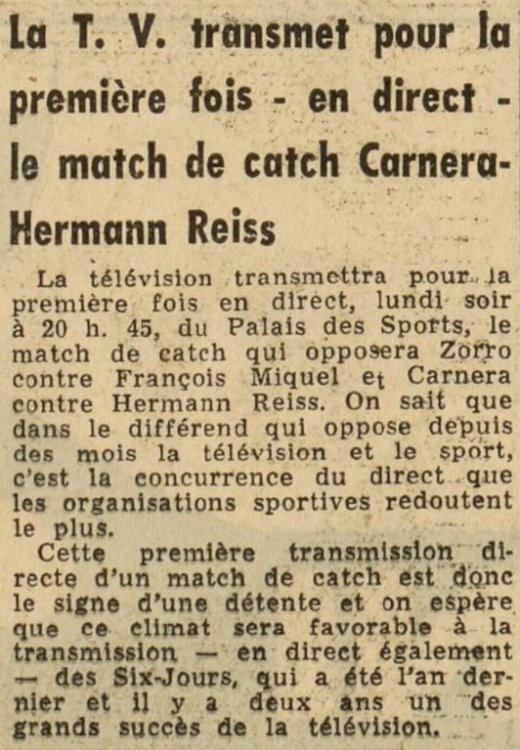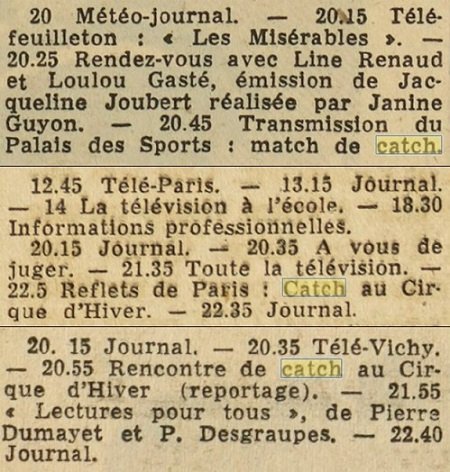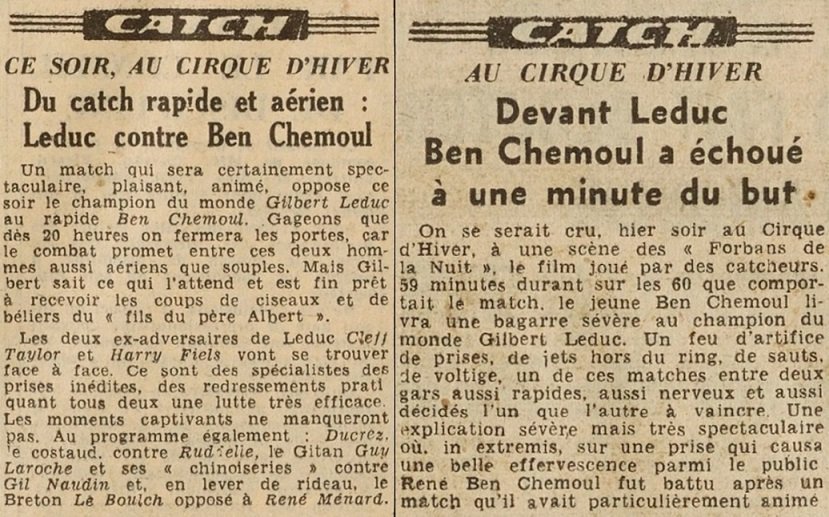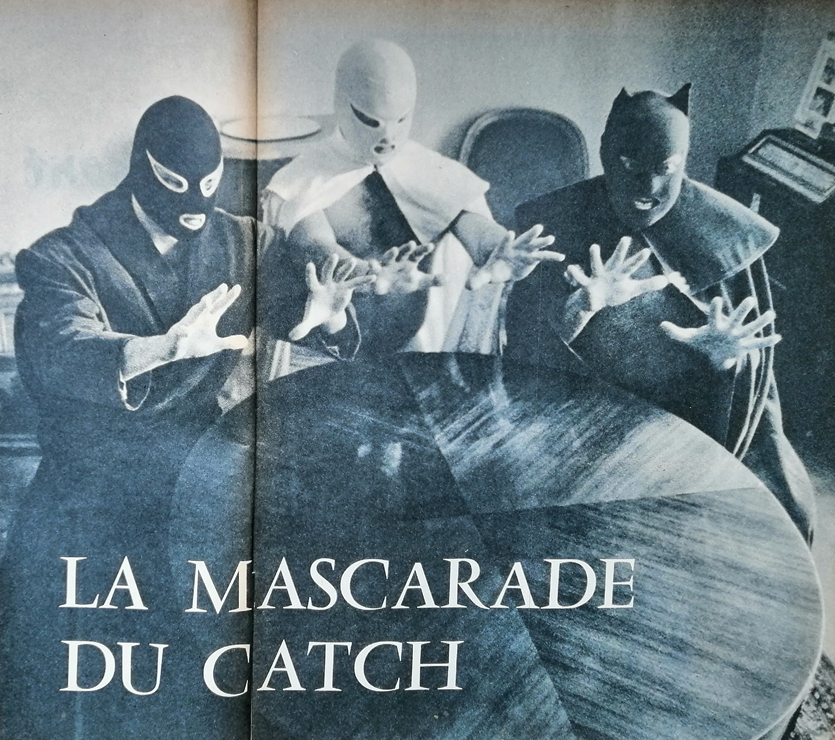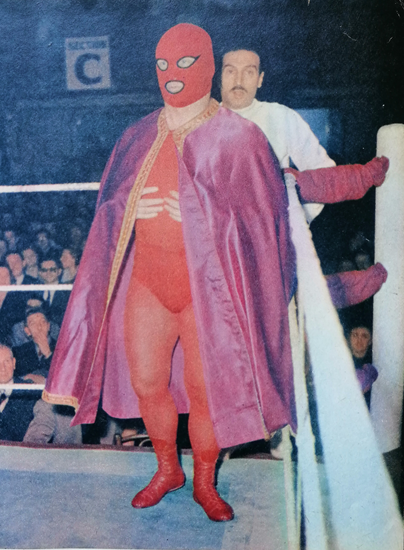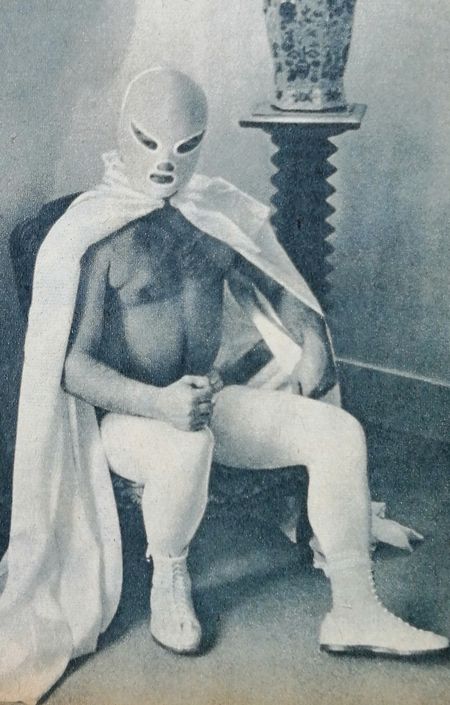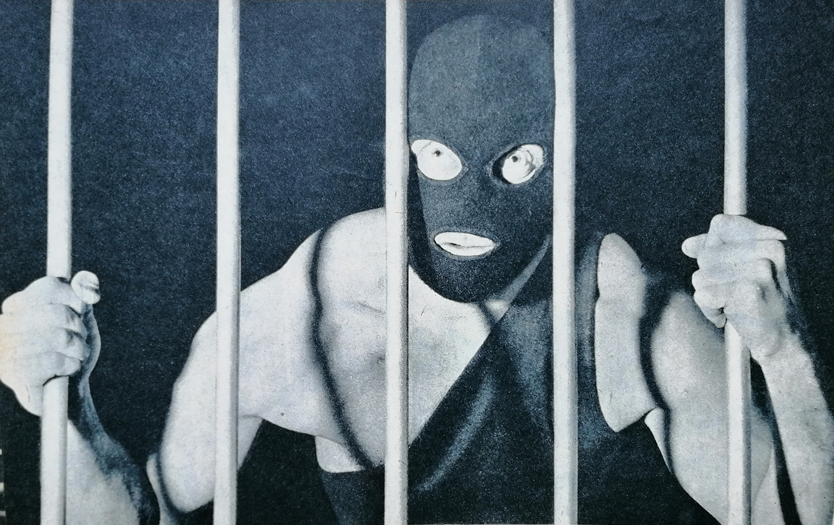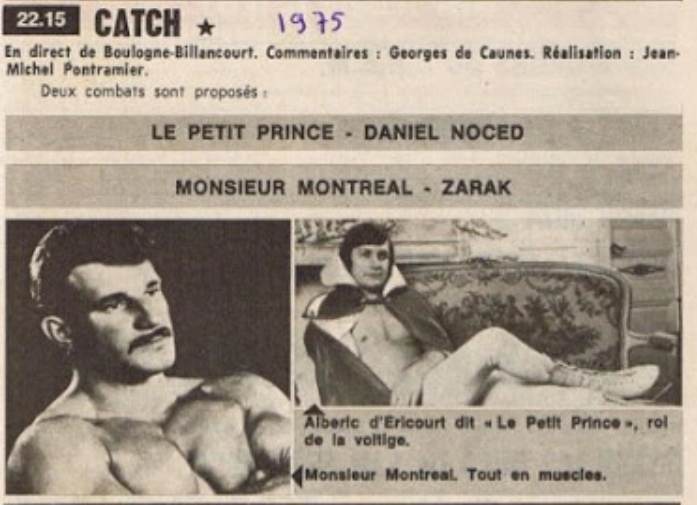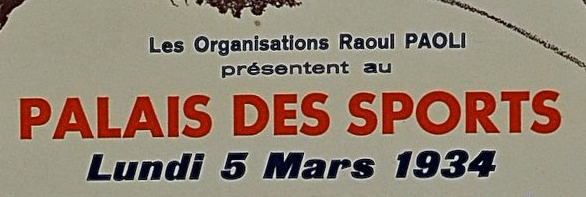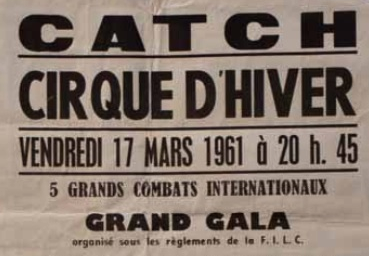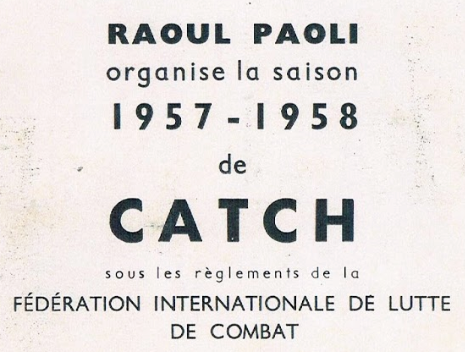
Phil Lions
Members-
Posts
214 -
Joined
-
Last visited
Content Type
Profiles
Forums
Blogs
Everything posted by Phil Lions
-
Yep. I just finally managed to get my hands on that magazine (the one with Delaporte on the cover), along with some other stuff from around the same time, and this is how I managed to piece everything together.
-
Here's a fun fact that I've been reading more about these past couple of days: this match got catch taken off TV. Not because of anything that happened in it, but because of the political ramifications of it. Here's what happened. First of all, just as a reminder, RTF's original agreement was with the four major promotions based out of Paris, which were to share the air time on the network. In early 1960 Jean Fryziuk, frustrated with the direction the business was headed in at the time (in his own words, too many masked gimmicks and too much clowning around), created his own promotion. Initially it was a small "indie" promotion with only a handful of affiliated wrestlers so despite now having his own company Fryziuk did continue taking some dates for the big promotions here and there too. In 1961, in the wake of L'Ange Blanc deciding to unmask and in the fallout from that, a bunch of guys left the Goldstein promotion, most importantly Goldstein's top mechants - Delaporte and Bollet. This was also when allegiances shifted a bit in the world of French catch as the Lageat/Siry promotion left the Goldstein/Chausson camp and joined up with Durand. After leaving Goldstein and up to the spring of 1962 Delaporte and Bollet were working for the Lageat/Siry/Durand group and then they, along with some others, joined forces with Fryziuk's promotion and tried to position that as the third major group. The name of the governing body for the promotion was Fédération Française de Lutte et de Catch Autonome (FFLCA). So when RTF decided to air the Delaporte vs. Fryziuk match, a FFLCA match, the other promoters raised a big fuss about this. Phone calls, threats, insults... The relationship of the promoters with RTF was already strained anyway, but this put things over the top. Roger Couderc, who had done the commentary for the Delaporte/Fryziuk match, announced that he's quitting catch commentary because of how much grief the promoters had been giving him and in general he was tired of dealing with their BS. Also, and more importantly, the head of sports at RTF Raymond Marcillac petitioned the head of the network to remove catch from the sports department of the network (his department) and put it in the hands of the entertainment department so that he didn't have to deal with the promoters anymore. He was tired of all the drama that came with dealing with the promoters and wanted nothing to do with them anymore. As a result catch was now off TV. Catch did return to TV later in 1962, but then got taken off TV again in 1963 only to be brought back in October 1963 when the promoters finally came to an agreement amongst themselves. So, in case you want to keep score: catch got taken off TV for a while on three separate occasions in the early 1960s (1961, 1962 and 1963). And just as a side note, here's where things stood in mid 1962 in terms of talent: - Goldstein/Chausson group: Voiney, Simunovich, Duranton, Hi Lee, Chemoul, Gueret, Amor, Said, Dula, Montreal, etc. - Lageat/Siry/Durand group: L'Ange, Bourreau, Leduc, Lasartesse, Gastel, Brown, Montourcy, Corn, Kamikaze, Laroche, etc. - FFLCA: Delaporte, Bollet, Fryziuk, Di Santo, Zarzecki, Calderon, Straub, Robert, etc.
-
@David Mantell The origins of the swimming pool matches. So, I've looked into it a bit and here's what I can confirm. As mentioned before, the earliest one that I can find is from September 1948 in Bordeaux, and INA has highlights of it, but it seems like the concept started picking up more steam in 1954 when the business as a whole became looser in terms of regulations (that's another story for another day). At that point the swimming pool matches were exclusively an "indie" concept, as in the major promotions had nothing to do with it. The main promotion, and perhaps even the only one, that was doing such matches at the time was CIC (Cercle International de Catch) and for a few years its shows were under the regulations of the FACA (Federation Autonome de Catch Amateur) governing body. Both were based out of Bordeaux. In addition to Bordeaux, CIC did shows in other French towns and eventually in the French territories in Africa too. CIC started as an "amateur catch" organization in 1947 (amateur catch is a big story in itself, a story for another day), but eventually when "amateur catch" faded away as a concept in France, CIC became a pro organization and worked with Lageat and Siry's FFCP and later on with others too. In 1947-1954 CIC had its own set of stars and champions (French, European and World), some of them being Yves Borne, Rene Mathieu, Manuel Cubera, Juan Pascual, James Bellivers, Dante Pozzi, etc. Most, if not all, of CIC's wrestlers were lightweights, welterweights and middleweights. Photos from 1954 in Bordeaux, Casablanca and Algiers:
-
^ And continuing that train of thought, I just found the following clipping from "Tele Magazine" (i.e. the French equivalent of "TV Guide" back then) confirming exactly how many catch broadcasts there were between 29 September 1956 and 31 August 1957. The point is, based on this, INA is missing 6 broadcasts from the last three months of 1956 and only 2 broadcasts from the next 8 months (we have 27, and there were 29). It's also interesting to note the magazine had an annual reader poll where they would ask the readers what they watched on TV, what changes they would like to see, etc. And according to their 1957 poll, 80% of the voters said they watch catch.
-
I've finished looking into 1954 and I can confirm the following. 1954 was the start of the catch broadcasts, but it appears there were only three broadcasts that year, all three by the Paoli-Goldstein promotion: - March 22 (from Palais des Sport) - Primo Carnera vs. Hermann Reiss + Francois Miquet vs. The Great Zorro - May 21 (from Cirque d'Hiver) - August 5 (from Cirque d'Hiver) INA doesn't have any of the footage. It's not clear what aired on the latter two broadcasts, but these were the cards of the live events that night (main event listed first): - May 21: Rene Ben Chemoul vs. Claude Montourcy... Charlie Fisher vs. Roger Guettier... Guy Laroche vs. Joachim La Barba... Roger Laroche vs. Albert Albisson... Gaby Dumas vs. Guebedjian - August 5: Charlie Fisher vs. Jean Casi... Bolo Hakawa vs. Marcel Manuel... Roger Delaporte vs. Guy Laroche... Moise Besch vs. Paul Roche... Fred Bauer vs. Andre Mouton It's interesting to note that the very first broadcast on March 22 happened because the creator of the popular variety TV show "36 chandelles" Jean Nohain got into a dispute with the network and as a result there ended up being a last-minute deal struck to air catch instead of the regularly scheduled "36 chandelles". A lot of the newspaper articles that I saw were very negative on catch because it replaced a beloved show, but apparently the viewing audience loved it and flooded the station with letters asking for more catch broadcasts on TV. Keep in mind though, at the time the promoters were apprehensive about having their shows air live on TV and there was fear that TV broadcasts would hurt the gates (not only of the broadcast show itself but of the other live events happening at the same time elsewhere in the territory). And that is a big reason why it took a while for the broadcasts to become more regular. I also found this interesting. There's a 16-minute women's wrestling segment from May 1954 that was produced for TV and INA still has the footage, but according to their records it was not aired on TV. It's a swimming pool women's tag team match. Could be the one I mentioned earlier or another one with the same women. It's not produced like typical catch though. There's 6 minutes of pre-match footage of the women arriving in France via airplane, then driving about and finally doing some training. The match itself is also shot differently with a lot of close-up shots and comedy. It ends with the referee being dumped in the swimming pool.
-
Turns out, that was wrong. INA has short highlights from a singles men's match from Bordeaux in September 1948. It's the same type of match, but in this case it's referred to as "catch nautique". Link to the footage: https://www.facebook.com/watch/?v=1196359814810027 ------ And while I'm on the topic of different types of catch, lately I've been looking into "catch amateur", which is a fascinating piece of French pro wrestling history that has been completely forgotten about. Long story short, they started doing it in the late 1940s and it quickly overtook pro wrestling (catch) as the most common type of catch in France as in by the looks of it there were more amateur catch events taking place than there were pro catch events (for example, in Paris there were typically 4 or 5 amateur catch events per week vs. 2 or 3 pro events). So what was this amateur catch? Well, it was presented as an amateur sport, an amateur version of the pro catch (with some minor rule differences), but it was 100% pro wrestling. Tons of future pro wrestlers did it. Heck, even active pro wrestlers like George Kidd and Mick McManus popped in for some amateur catch. Look no further than this video from an amateur catch match that I shared yesterday on Twitter as proof that it was pro wrestling despite not being billed as such: Joachim la Barba vs. Rene Bouchoucha in 1952 So why present it as amateur instead of pro, which it clearly was? Because by calling it amateur they were able to save millions of francs on taxes as amateur events didn't have to pay the taxes that the pro events had to pay. And as you can imagine the French authorities eventually figured this out and lawsuits and fines followed. And that's not even half of it. Amateur catch had a big role in the first major promotional war in French pro wrestling breaking out. Anyway, I'll discuss this in more detail in my French catch timeline. French pro wrestling history in seriously fascinating. There's a lot of unique twists and turns in it that are unlike anywhere else in the world. The more I dig, the more I become fascinated by it.
-
Came across an article from January 1950 where several French celebrities talk about why they like catch while also commenting about whether or not the catch matches were predetermined. I thought that's quite neat so I'll share here what they said. Albert Préjean (actor): "You can say what you want about catch, but... it's a sport. Besides, about tricks, I don't think there are as many as people say. For example, I had a friend who performed a hand-to-hand act. He was also a wrestler in his spare time. While performing his act, he never got hurt. While wrestling, he broke his nose. Breaking your nose is not a show, after all. I think the public goes to see the lightweight matches because of the spectacular appeal of these encounters, and the heavyweight matches for sadism. They always hope that one of the two wrestlers will get their head torn off..." Milly Mathis (actress): "What I am trying to understand is how, after having wrestled for an hour on the mat, the two wrestlers manage to find all their limbs. They must be flexible, it leaves me speechless to see such big gentlemen twisting and undoing themselves like that... As for knowing whether it is fake or not, that is their business..." Marcel Achard (author): "It's very good theater, although in my opinion they are not all rigged. I acquired a taste for catch during my stay in the United States. I saw a certain Jim Londos wrestle there, who must have been the world champion. What a guy! His great hobby was to throw his opponent over the ropes. And not in the front row. Up to the fifth or sixth. I never sat there..." Alfred Adam (actor): "I'm not looking for the same pleasure in catch as in boxing. Boxing is a dark, dramatic thing. Sometimes dirty. Catch is the opposite. What actors these wrestlers are. What an art to portray suffering, anger, fear... For me, the audience of catch today is the one who, fifty years ago, was passionate about melodrama. I don't mean by that that catch is just bluff. I believe that in the end it's the best who wins. In any case, we would be wrong to underestimate the athletic value of the matches." Francis Lopez (composer): "It reminds me of my job. Because between us it's great music, and well orchestrated..." That same article mentions that they had recently done a survey asking people whether they thought the catch matches were real and according to their poll 75% of the spectators were convinced of the sincerity, if not of all the matches, at least of the most important ones.
-
It wasn't televised, but man does this sound like something I wish we could watch. February 9, 1951. A young Gilbert Leduc wrestled a young Rene Ben Chemoul for 59 minutes in Paris. "A fireworks display of holds, throws out of the ring, jumps, and acrobatics" is how the report on the right described it.
-
Earlier today the 1954 French newspapers were put online (under French copyright law 70 years since the date of publication need to have passed for the papers to be made publicly available online) and that has now allowed me to finally answer the question: when did catch first air on TV in France? As mentioned before, catch highlights started airing as part of the TV news in 1949, but the first actual broadcast was on March 22, 1954, from Palais des Sport (i.e. the Paoli-Goldstein promotion). That night Primo Carnera vs. Hermann Reiss and Francois Miquet vs. The Great Zorro (Hans Mortier) aired live on TV at 8:45 pm. Claude Darget did the commentary. This broadcast was just a one-off, I believe. I've yet to research 1954 more thoroughly, but for now it seems like this was the only broadcast that year. On another fun note, I haven't looked much into it, but according to this one article I saw the first ever "catch aquatique" match in France took place on May 8, 1954, in Saint-Germain-en-Laye. It was a women's tag team match with the ring in the middle of a big pool.
-
I haven't decided yet. I have about 160 pages worth of notes, articles, etc. and I'm still going through them trying to piece together the whole timeline and make it as coherent as possible. Plus, I'm also still looking into gathering additional information on top of that and trying to fill in some of the gaps. Most likely I'll end it at the end of the 1980s. And I don't see myself going into much detail past the mid 1960s. Not because I don't want to, but because I don't have enough info.
-
Yes, it was them and actually this is a very good point that I didn't think to add to my write-up. I'll add some extra details now. Thanks!
-
And here it is. Part one of the catch timeline that I've been working on. It goes up to 1940 when all pro wrestling was banned in France. There will be a part two eventually which will cover the post-WWII period. Link: Timeline - French catch
-
Just came across these and I thought I'd share them here. Tony Oliver as Le Justicier Blanc (Maurice Durand's L'Ange Blanc ripoff): A few masked characters from the Durand promotion (April 1959): Superman, Le Justicier Blanc and El Diablo. Le Bourreau de Bethune in color: And finally, I love this one of L'Homme Masque (The Great Zorro/Hans Mortier, I assume):
-
Don't know. Yes, I know they were, but I'm certain the year is either 1968 or 1974 because of the poster. It had a date + day of the week combination, which can only be one of those two years.
-
A poster for a show in Amiens advertising a rematch of a TV match and it really sucks that INA doesn't have this particular one, especially if this was Aledo: Le Petit Prince vs. Kamikaze! I'm not sure about the year, but it has to be either 1968 or 1974. Plus, based on this TV listing below, we're also missing a pair of matches from 1975: Le Petit Prince vs. Daniel Noced and Monsieur Montreal vs. Zarak.
-
^ A fine choice! I'd probably go with Palais de la Mutualite, but it's a very tough call. Meanwhile, I just confirmed another TV match that's missing from the INA archive: L’Ange Blanc & Eddy Mores vs. Robert Duranton & Firmin from some point in 1979. How do I know that match aired on TV? Because here we have part of a poster for an April 21, 1979, show that's advertising a rematch of the TV bout. This was all part of L'Ange Blanc's retirement tour in 1979.
-
At one point the Paris audiences were so spoiled for choice it's not even funny. This particular example is a bit out of the norm, but still. Check this out. Just came across it. Picture this scenario. It's February 9, 1958. A Sunday. You happen to be in Paris and you realize that in the afternoon there's not one, not two, not three, but four catch shows happening at the same time (3:30 pm starting time for three of the shows and 3 pm for the final one). Which one do you go to? So many choices! Palais de la Mutualite: 1. Jean Rabut vs. Roland Daumal 2. Jacky Corn vs. Eric Husberg 3. Franz Orlik vs. Lino Di Santo 4. Jose Tarres vs. Robert Gastel 5. Hermann Iffland vs. Liano Pellacani Lancry Arena: 1. Jean Fryziuk vs. Gilbert Cesca 2. Yanek Anski vs. Ferdinand Bauer 3. Georges Gueret vs. Arabet Said 4. Al Hayes vs. Yves Amor 5. Roger Delaporte vs. Serge Gentilly Elysee-Montmartre: 1. Henri Le Mao vs. Jacques Couderc 2. Johnny Morandi vs. Marc Gaillard 3. George Kidd vs. Guy Laroche 4. Roger Laroche vs. Claude Montourcy 5. Robert Duranton vs. Jose Arroyo Stadium: 1. Berrigaud vs. Henri Cointepas 2. Robert Moine vs. Gaston Maujean 3. Inca Peruano vs. Jo Labat 4. Pierre Boss vs. Warnia de Zarzecki 5. Gilbert Leduc vs. Tommy Mann
-
As part of my research I've been going through old French posters and programs and just got to this one. Here's an excellent example from an autumn 1957 program for Palais des Sports: "Raoul Paoli promotes the 1957-1958 season of CATCH under the regulations of FILC". This sentence is a perfect illustration of how things worked in France (1940s-1980s) when it came to promotional names. Names of promotions didn't really matter in the grand scheme of things. It was never "FFLP presents" or "FFCP presents" . It was always such and such promoter or venue presents CATCH under the regulations of such and such federation. The promotional names were never the focal point and the shows were never pushed as a FFLP show, a FFCP show, etc. like we're used to pro wrestling shows being presented in the past few decades. The promotional names were just used as the governing bodies that supposedly set the rules. Hardly anyone remembers or cares about those names. If you were to ask older French wrestlers what promotion they worked for they'd never say "I worked for FFLP, FFCP, etc." They'd say "I worked for Delaporte, Goldstein, etc." or the name of the venue. And I don't think the fans cared about the promotional names either. The press sure didn't. That said, some of those promotional names started out as legit governing bodies, but that's another topic for another day.
-
Here it is. Written by Claude Rocca. I made a few minor edits and added some notes [in brackets], but other than that everything is as Rocca wrote it. I do get a sense of some exaggeration at times, but honestly that is to be expected given how French wrestlers tend to view the glory days of catch and Leduc in particular. Either way, I think it's a nice little summary of Leduc.
-
^ Thanks. I was going through Bob Plantin's blog yesterday and came across a pretty good article on Gilbert Leduc that summarizes well who he was. I'll get it translated and tweet it at some point in the next few days. I'll make sure to tag Brian and Jim too. Meanwhile, a few additional nuggets of information that I've just come across: According to an article I saw, the original Der Henker was Johnny Stein, then Freddy Robert got the gimmick, and finally in the early 1970s it was Remy Bayle. Before that in the first half of the 1960s Bayle had done another masked gimmick - Le Justicier du Ring (a L'Ange Blanc rip-off which, it seems, a few guys worked as over the years). Luna Catch 2000 was created by... Ted Lamar (real name Albert Lafeuille). Lamar's other notable accomplishment was being Jean Ferre's opponent in Ferre's debut match. La Bête Humaine in the 1971 footage was Nick Sanders (real name Paul Papayre from Bordeaux). Sanders had a rugby background (which Bob Plantin had also mentioned to me in the past). He was brought to Paris and managed by Paul Marton. The Hungarian Paul Marton was one of the men behind the number two French promotion back in the 1930s (based out of Elysee-Montmartre). In the second half of the 1940s he took over as promoter at Salle Wagram. He was also the one who brought Gilbert Leduc into pro wrestling. Eventually in the 1950s Maurice Durand took over Salle Wagram and I had figured that meant Marton was out of the scene altogether, but apparently not - he was still active in Paris in the early 1970s. I'm not sure of the year (definitely before 1973) but apparently at one point there was a Guy Mercier vs. Kamikaze match on TV in France where Kamikaze ended up unmasking and was revealed as Modesto Aledo indeed. Well, sort of. His face was actually painted up so you couldn't really tell it was him but according to an article I saw it was him.
-
"Les Organisations Raoul Paoli" or "Raoul Paoli Promotions", if you prefer its English-language equivalent. Here it is on a poster from 1934: In the 1950s Paoli's promotion merged with Goldstein's promotion and eventually that became "Fédération Internationale de Lutte et de Combat" (FILC). Here it is on a poster from 1961 down at the bottom: Anyway, this will all be in my upcoming catch timeline. Up until the early 1960s I've got stuff mostly figured out, with a few notable gaps. After that it gets much trickier to figure out. The bad news is that French copyright laws are such that 70 years need to have passed since the original date of publication for them to be able to make newspapers digitally available, which means that right now almost nothing past 1953 is available (for a while there were some post-1953 newspapers available, but then they got taken down). So yeah, it would be quite a while until the 60s, 70s and beyond newspapers become available online and we're able to do more thorough research on those decades...
-
I finished reading the new Marc Mercier book that was just released. It's a mix of stories about Marc's father and family, Marc's career as a wrestler, Marc's movie career, Marc's personal life and Marc's days as a promoter. I found it enjoyable, mostly because it's not often that you get to read books set in the world of catch, and overall it's a solid account of Marc's life, but some parts of the book I don't buy. At times there's definitely exaggeration in there and also some stuff that is absolutely not true. The most amusing example of both being Marc claiming that his father was a huge star in Zurich and with him on the card they were regularly drawing 47,000 people (mind you, the venue he mentions cannot hold more than 15,000) until one time when he wasn't on the card and the attendance was 1,500... A few interesting nuggets of info from the book: José Gonzales' real name was... Daniel Lequec, a Frenchman. The Golden Falcons were Guy Renaud and Robert Torres. That was in 1977. Later they also wrestled as Les Panthers, a nazi-esque gimmick. Marc was trained by Michel Chaisne at Louis Michon's catch school in Paris. Guy Renaud and Robert Torres also had a big hand in training him. Marc's debut match in 1977 was against Bruno Lequec (José Gonzales' son). Marc's big break, and he got it less than a year into his career (according to him because Roger Couderc recommended him), was working for Delaporte at Elysee-Montmartre. He has a very high opinion of Delaporte. If Marc's narrative (i.e. his claims of regular TV appearances by his father and later by him) is to be believed, then INA is missing quite a few matches. At one point Delaporte teamed up Marc with Gérard Hervé (Flesh Gordon) under the tag team name Les Playboys. Marc says they worked as a team for about three years and he talks very fondly of this time. Marc says Delaporte didn't like Gordon very much, because he found him to be arrogant and eventually Delaporte fired Gordon, which led to Gordon starting his own company. Marc credits Gordon for talking him into returning to the ring in the early 2000s (Marc had retired in 1989 after a serious car accident). Eventually Marc decided to leave Gordon's promotion and start his own company so in April 2006 he bought the FFCP name from Delaporte. He says he didn't feel at home in Gordon's promotion and didn't like how the younger generation was treating him. He told Gordon about starting the new company and wanted them to work together and share the French market. At first they were working together and Gordon was sending Marc talent, but then their relationship turned sour. In the book he keeps taking shots at a certain "rich promoter", one of the French ones, and never mentions him by name. I can't quite figure out who he's referring to. It was someone who he says was in a few car crashes and one of them led to the death of an English wrestler (not mentioned by name). He paints Duranton specifically in a pretty negative light and makes him out to be very arrogant. At one point he mentions the term "bourre", which kind of surprised me. "Bourre" and "chiqué" were the old Greco-Roman pro wrestling terms for shoot and work, respectively, used in the times of Paul Pons before WWI. Didn't expect to see such a term used in a book about catch. However, it seems over time "bourre" became the term for wrestlers having a private gym match to see who the better man is. Mercier used it in that context and I checked with Bob Plantin, who confirmed he also knows the term in that context. In the times of Pons it was used for shoot matches in front the crowd too. According to Marc, before championship matches wrestlers used to have "bourre" bouts in front of their colleagues and the winner would then be booked to win the championship match. He doesn't explicitly say it, but he mentions the "bourre" stuff right after talking about the 1960s so this gives the impression this championship-deciding practice was happening in the 1960s, which I don't believe. Heck, I don't believe they were doing it in the 1930s either, let alone the 1960s. Either way though, it's interesting to see that the term "bourre" traveled through the decades. He also uses the term "mourir" (to die) as the term for "selling". No. My new research has confirmed that this is definitely not correct and it's something that people often get wrong (Mercier gets it wrong in his book too). FFCP was started by Etienne Siry and Robert Lageat in 1950 and at first it was just a governing body for catch (a rival governing body to the one Paoli, Goldstein and others were working with). At that point there were still no promotional names. FFCP later became the name of the Siry/Lageat promotion. I'm not clear on the timeline after this, but I guess later Delaporte ended up with the FFCP name and then in 2006 Mercier bought it from him.
-
Over the weekend I started researching the career of Gilbert Leduc more in-depth than I ever have in the past, because I want to help push his case for the WON HOF next year, and in doing so I ended up uncovering a bunch of new information on how catch worked in France on an organizational level in the post-WWII years through the mid 1950s. I became so intrigued by it that I've paused the Leduc research for now and have focused my efforts on the organizational stuff instead. Apparently, things were a lot more interesting and tumultuous back then than I realized (rival organizations, lawsuits, potential corruption...). So now I've decided to do a timeline/article chronicling all the important events in French catch history that I'm aware of. Haven't decided yet what year would be the cut-off point. I'll share the link here once it's ready, hopefully in the next few weeks.
-
Der Henker is one of the more amusing gimmicks to me. Durand saw the success of L'Homme Masque so with Le Bourreau de Béthune he created his own L'Homme Masque but instead of black made him red. Goldstein then returned the favour by introducing Der Henker a.k.a. Le Masque Rouge. In short, Der Henker was an imitation of an imitation, which I find amusing. And that guy in the video is definitely not Verdu. He had a different build. That said, based on photos and videos that I've seen, more than one person did the Der Henker gimmick over the years, which is par for the course for France. It's certainly possible for Verdu to have been one of the Der Henkers at some point.
-
Had a feeling you had something to do with it, but didn't want to call you out. Thanks! Kellet and Grey I don't know too much about as the TV era of the UK isn't really my area of expertise, but I'm looking forward to eventually digging in more on them. It's good to have some new faces in the mix for that section of the ballot.
